
FAIR is a non-profit organization dedicated to providing well-documented answers to criticisms of the doctrine, practice, and history of The Church of Jesus Christ of Latter-day Saints.
(m) |
|||
| Line 141: | Line 141: | ||
Of further interest, one critic assumes that the document referred to as the "Egyptian Alphabet" by "A Gentile" was, in reality, the Anthon transcript. He offers his own "reconstruction" of a deconstructed "boat" character on the Anthon transcript similar to that demonstrated by Don Bradley which matches the "boat" character on the ''Grammar and Alphabet of the Egyptian Language'', thereby ''removing the "boat" character from the Kinderhook plates themselves from the process''. Once you link to the character on the GAEL, the entire "translation" produced by Joseph comes with it: | Of further interest, one critic assumes that the document referred to as the "Egyptian Alphabet" by "A Gentile" was, in reality, the Anthon transcript. He offers his own "reconstruction" of a deconstructed "boat" character on the Anthon transcript similar to that demonstrated by Don Bradley which matches the "boat" character on the ''Grammar and Alphabet of the Egyptian Language'', thereby ''removing the "boat" character from the Kinderhook plates themselves from the process''. Once you link to the character on the GAEL, the entire "translation" produced by Joseph comes with it: | ||
[[File:Jeremys boat.jpg|center|500px|thumb|A "reconstruction" by a critic of a "boat" character from the Anthon transcript matched to the corresponding character from the ''Grammar and Alphabet of the Egyptian Language'' (GAEL). Given that it has been demonstrated by Don Bradley that the GAEL "boat" character shown correlates with Joseph's "translation" of a portion of the Kinderhook plates, we are unsure why the critic has "proven" that Joseph "translated" a portion of the Anthon transcript instead.<ref name="debunking">Jeremy Runnells, "Debunking | [[File:Jeremys boat.jpg|center|500px|thumb|A "reconstruction" by a critic of a "boat" character from the Anthon transcript matched to the corresponding character from the ''Grammar and Alphabet of the Egyptian Language'' (GAEL). Given that it has been demonstrated by Don Bradley that the GAEL "boat" character shown correlates with Joseph's "translation" of a portion of the Kinderhook plates, we are unsure why the critic has "proven" that Joseph "translated" a portion of the Anthon transcript instead.<ref name="debunking">Jeremy Runnells, "Debunking FairMormon - A Letter to a CES Director" (2014)"</ref> ]] | ||
So, let's assume that Joseph ''did'' use the "boat" character from the Anthon transcript. The critic demonstrates a match between a "boat" character on the Anthon transcript ''and the corresponding character on the Grammar and Alphabet of the Egyptian Language'''! All he has done is ''remove the actual Kinderhook plates'' from Don Bradley's explanation! | So, let's assume that Joseph ''did'' use the "boat" character from the Anthon transcript. The critic demonstrates a match between a "boat" character on the Anthon transcript ''and the corresponding character on the Grammar and Alphabet of the Egyptian Language'''! All he has done is ''remove the actual Kinderhook plates'' from Don Bradley's explanation! | ||
Given the evidence that the Kinderhook plates were fraudulent, how can one explain the following things?
To see citations to the critical sources for these claims, [[../CriticalSources|click here]]
Joseph Smith's personal secretary, William Clayton said,
President Joseph has translated a portion [of the Kinderhook plates], and says they contain the history of the person with whom they were found; and he was a descendant of Ham, through the loins of Pharaoh, King of Egypt, and that he received his kingdom through the ruler of heaven and earth.
The Kinderhook plates were fakes, thus bringing into question any claim of "inspiration" that Joseph used to translate them and by extension any other revelations he received.
However, Joseph Smith "translated" a portion of those plates, not by claiming inspiration, but by comparing characters on the plates to those on his "Grammar and Alphabet of the Egyptian Language" (GAEL). (The GAEL was composed in Kirtland about the time of the translation of the Book of Abraham.) Joseph found one of the most prominent characters on the plates to match a character on the second page of characters in the GAEL. Both were boat shaped. The GAEL interpretation of this boat-shaped character included everything that William Clayton said Joseph said.
Corroborating this is a letter in the New York Herald for May 30th, 1843, from someone who signed as "A Gentile." Research shows "A Gentile" to be a friendly non-Mormon then living in Nauvoo:
The plates are evidently brass, and are covered on both sides with hieroglyphics. They were brought up and shown to Joseph Smith. He compared them, in my presence, with his Egyptian Alphabet…and they are evidently the same characters. He therefore will be able to decipher them.
We know that Joseph was interested in languages. He studied Greek, Hebrew, and German in a secular manner. Therefore, we can easily believe that he attempted to translate the Kinderhook plates without assuming prophetic powers, which powers consequently remain credible.
So, a larger conclusion that we can draw is that we’ve got both the smoking-gun – the GAEL that he uses to translate, and we’ve got an eyewitness. We know exactly how Joseph Smith attempted to translate from the Kinderhook plates and obtain the content that Clayton says he did. A larger conclusion, then, that we can draw is that Joseph Smith translated from the Kinderhook plates not by revelation, but by non-revelatory means.

A set of small plates, engraved with characters of ancient appearance, were purported to have been unearthed in Kinderhook, Illinois, in April 1843. The so-called "Kinderhook plates" have been something of an enigma within the Mormon community since they first appeared. While there are faithful LDS who take a number of different positions on the topic of these artifacts, most have concluded that they were fakes.
Joseph Smith appears to have had the plates in his possession for about five days.
The following is from Stanley B. Kimball, "Kinderhook Plates Brought to Joseph Smith Appear to Be a Nineteenth-Century Hoax," Ensign, August 1981 off-site
These two oblique references to a “translation” were followed thirteen years later by a more direct published statement that until recently was wrongly thought to have been written by Joseph Smith himself. On September 3 and 10, 1856, the following paragraphs appeared in the Deseret News as part of the serialized “History of Joseph Smith”:
“[May 1, 1843:] I insert fac similes of the six brass plates found near Kinderhook, in Pike county, Illinois, on April 23, by Mr. R. Wiley and others, while excavating a large mound. They found a skeleton about six feet from the surface of the earth, which must have stood nine feet high. The plates were found on the breast of the skeleton, and were covered on both sides with ancient characters.
“I have translated a portion of them, and find they contain the history of the person with whom they were found. He was a descendant of Ham, through the loins of Pharaoh, king of Egypt, and that he received his kingdom from the ruler of heaven and earth.” (Then followed a reprint of material from the Times and Seasons article.)
Although this account appears to be the writing of Joseph Smith, it is actually an excerpt from a journal of William Clayton. It has been well known that the serialized “History of Joseph Smith” consists largely of items from other persons’ personal journals and other sources, collected during Joseph Smith’s lifetime and continued after the Saints were in Utah, then edited and pieced together to form a history of the Prophet’s life “in his own words.” It was not uncommon in the nineteenth century for biographers to put the narrative in the first person when compiling a biographical work, even though the subject of the biography did not actually say or write all the words attributed to him; thus the narrative would represent a faithful report of what others felt would be helpful to print. The Clayton journal excerpt was one item used in this way. For example, the words “I have translated a portion” originally read “President J. has translated a portion. …”
Don Bradley presented compelling evidence during his 2011 FAIR Conference presentation that Joseph Smith did indeed attempt to translate a character on the Kinderhook Plates. [1] Bradley noted that William Clayton's account is likely representing personal and specific knowledge acquired from Joseph Smith, since evidence indicates that he made his journal entries that day while he was at the Prophet's home. Clayton's account states that
Bradley noted that one of the most prominent characters on the Kinderhook Plates (a symbol shaped like a boat), when broken down into its individual elements matched a symbol found on page 4 (the second page of characters) of the Grammar and Alphabet of the Egyptian Language (GAEL), often referred to as the "Egyptian Alphabet. The GAEL provides meanings for the individual symbols, and the meaning assigned to the particular symbol found on the plates supports the translation reported to have been provided by Joseph.
The conclusion is that Clayton's account appears to be accurate, that Joseph did attempt to translate "a portion" of them by non-revelatory means, and the translation provided matches a corresponding symbol and explanation in the GAEL.
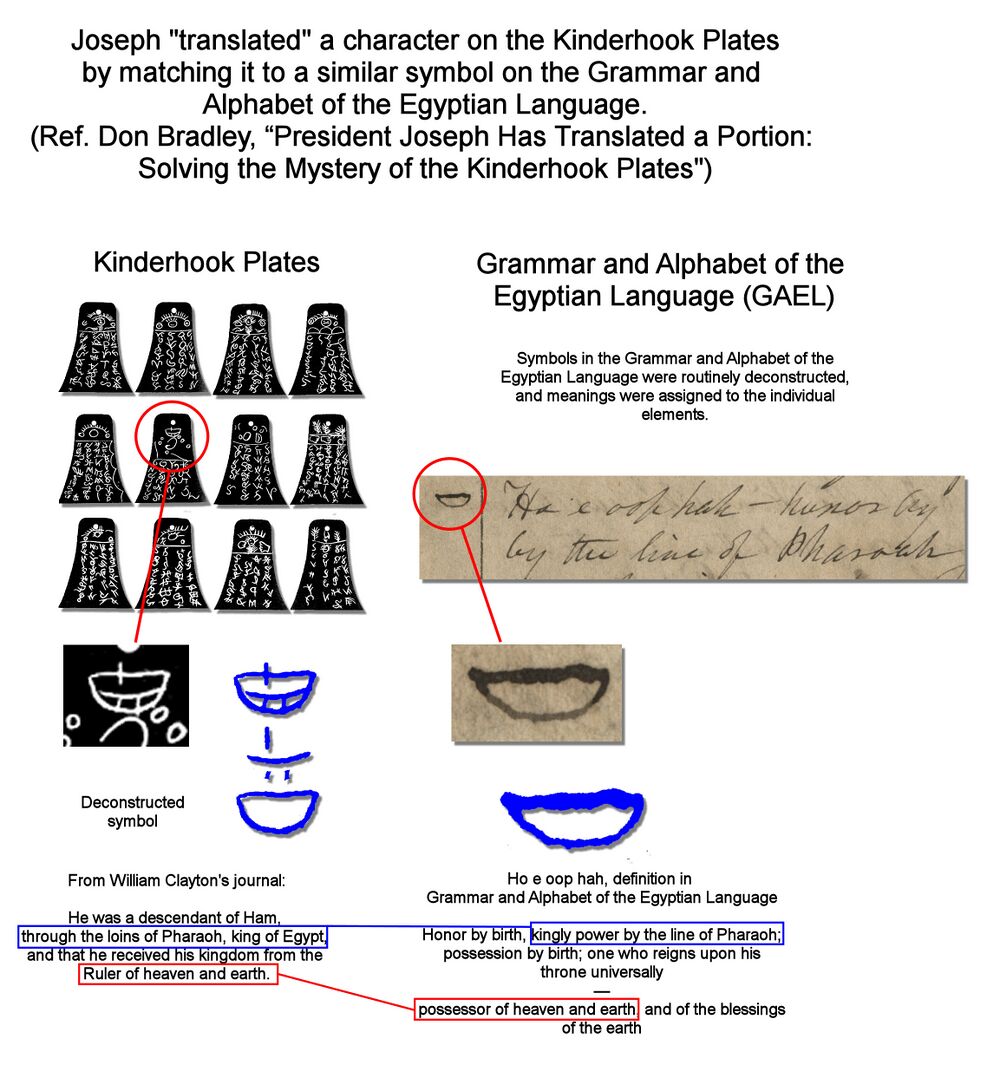
At the time that Joseph Smith translated the Book of Mormon, he only claimed the ability to translate by the "gift and power of God." Over time, Joseph studied other languages and wished to learn to translate by other means. His attempt to use the Grammar and Alphabet of the Egyptian Language (a document that he and others had created) to attempt a translation of the Kinderhook Plates fits in with this desire. Since only a single character "matched," Joseph would have been unable to continue to translate the plates in this manner. This may explain why such a translation was never produced: beyond the single character which happened to match, it would not have even been possible to translate the fraudulent plates either manually or by the "gift and power of God." Therefore, no translation was ever produced.
A critical graphic from "mormoninfographics" states that "Joseph didn't discern the fraud. The LDS Church now concedes it's a hoax. What does this tell us about Joseph Smith's gift of translation?"
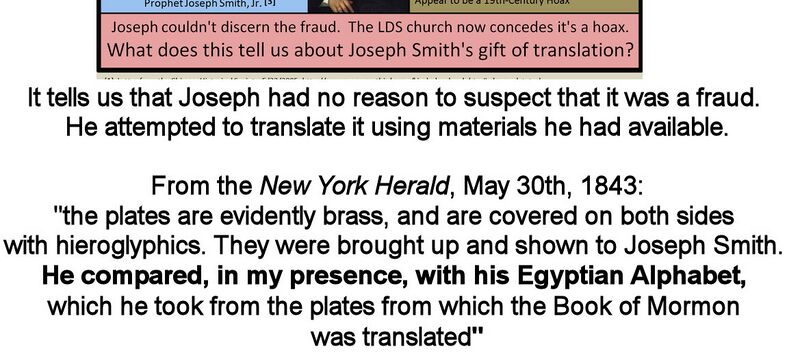
An eyewitness stated that Joseph compared the Kinderhook plates with the Egyptian Alphabet and Grammar. The translation produced supports this. He did not attempt to translate using his "gift of translation." Note that the eyewitness, a non-Mormon, assumed that the "Egyptian Alphabet" was "from the plates which the Book of Mormon was translated." Don Bradley explains this in the quote below. The "Egyptian Alphabet" was not taken from the Book of Mormon plates, and the characters copied from the plates by Joseph, known as the "Anthon transcript," has never been referred to as the "Egyptian Alphabet." The "Egyptian Alphabet," also known as the "Grammar and Alphabet of the Egyptian Language" (GAEL) was created after the translation of the Book of Abraham.
From Don Bradley, "‘President Joseph Has Translated a Portion’: Solving the Mystery of the Kinderhook Plates":
"[T]he [Kinderhook] plates are evidently brass, and are covered on both sides with hieroglyphics. They were brought up and shown to Joseph Smith. He compared, in my presence, with his Egyptian Alphabet,” Now, the guys a non-Mormon here, and so he doesn’t actually understand what this Egyptian Alphabet is. So he says, “which he took from the plates which the Book of Mormon was translated,” but he doesn’t know it’s from the Book of Abraham papyrus, he says, “He compared, in my presence, with his Egyptian Alphabet…and they’re evidently the same characters. He therefore will be able to decipher them.” So this is the Alphabet and Grammar volume, and you can see the title on the spine says “Egyptian Alphabet.” Now, Robin Jenson, of the Joseph Smith papers tells me that we don’t know when this label was added, it could have been added in Utah. If it was added early on, then this “gentile” would have seen this on the spine and obviously would have called it the “Egyptian Alphabet.” Even if it is a later name that is affixed to it, it shows what the Saints actually knew this volume as, they knew it as “Egyptian Alphabet.” So that is likely the name under which he would have heard of it.

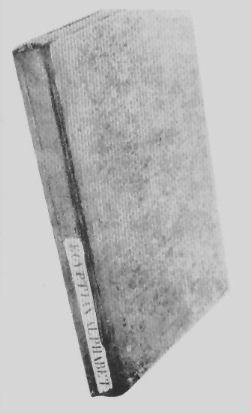
The Grammar and Alphabet of the Egyptian Language was produced between July and December 1835 in Kirtland, Ohio. The document was produced around the time that the Book of Abraham was dictated, and it is in the handwriting of William W. Phelps and Warren Parrish. The original documents may be view on the Joseph Smith Papers website: Grammar and Alphabet of the Egyptian Language, circa July–circa December 1835. For more information about the relationship of the GAEL to the Book of Abraham, see: Kirtland Egyptian Papers.
It is noted that Joseph did indeed have a copy of the Book of Mormon characters in his possession in December 1842, months after he saw the Kinderhook plates. The following is a diary entry from the Reverend George Moore:
Tuesday Evening, December 19th (1843)
Called on the "Prophet Jo [Joseph] Smith." His carriage was at the door and he was about going away, but he received me very kindly, asked me into his house. I remained about 10 minutes. He was very communicative. We conversed about the golden plates, which he professes to have dug up and translated into the Book of Mormon. "Those plates are not now in this country," he said--"they were exhibited to a few at first for the sake of obtaining their testimony--no others have ever seen them--and they will never again be exhibited." He showed me some specimens of the hieroglyphics, such as, he says, were on the gold plates. He asked me if I was a Clergyman--and of what denomination--and what were the fundamental doctrines of our faith--on my telling him that we believed in divine Unity--in one God in one person--he said, we don't agree with you there. We believe in three Gods, equal in power and glory. There are three personages in heaven, but those three are not one. I suppose, from what I hear, that Smith makes it a point not to agree with any one in regard to his religious opinions, and adapts himself to the person with whom he talks for the time being . . . He expressed a desire to have a long conversation with me, but he had an engagement, and I was soon going away, so that we could not have much conversation. Our interview was short, but pleasant. [Diary, pp. 105-106.] [2]
Therefore, Joseph had a copy of the Book of Mormon characters and he did show them to someone. As our critic puts it, "Joseph Smith was parading around and showing others the Egyptian hieroglyphics he copied off the gold plates around the same time as the discovery of the Kinderhook Plates." [3] Could this not be the source of the comment from "A Gentile" that the Egyptian Alphabet came "from the plates which the Book of Mormon was translated?"
Moores's diary entry doesn't seem to indicate that Joseph was "parading around and showing others," but he does seem to have shown Moore what he would have referred to as "reformed Egyptian" characters. However, there was already a document in existence called the Grammar and Alphabet of the Egyptian Language for the last eight years - it would certainly have been known to the Saints as the "Egyptian Alphabet," whereas the Anthon transcript, to our knowledge, was never referred to by that name.
Of further interest, one critic assumes that the document referred to as the "Egyptian Alphabet" by "A Gentile" was, in reality, the Anthon transcript. He offers his own "reconstruction" of a deconstructed "boat" character on the Anthon transcript similar to that demonstrated by Don Bradley which matches the "boat" character on the Grammar and Alphabet of the Egyptian Language, thereby removing the "boat" character from the Kinderhook plates themselves from the process. Once you link to the character on the GAEL, the entire "translation" produced by Joseph comes with it:
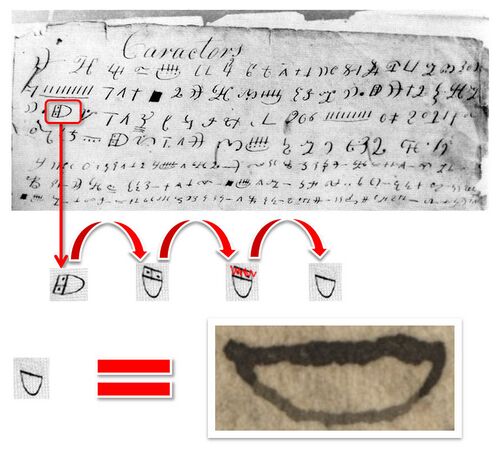
So, let's assume that Joseph did use the "boat" character from the Anthon transcript. The critic demonstrates a match between a "boat" character on the Anthon transcript and the corresponding character on the Grammar and Alphabet of the Egyptian Language'! All he has done is remove the actual Kinderhook plates from Don Bradley's explanation!
To summarize:
Moreover, it makes absolutely no sense that Joseph would have used the Anthon transcript in any attempt to "translate" the Kinderhook Plates - there is no extant translation of the Anthon transcript characters. The characters likely came from the portion of the Book of Mormon plates corresponding to the lost 116 pages, and no translation of these characters was ever recorded by Joseph Smith. Don Bradley's Kinderhook explanation, however, clearly links the "boat" character on the GAEL and its assigned meaning with the actual "translation" of a portion of the Kinderhook plates produced by Joseph. The text shows a correlation.
The critics are missing the point in that the GAEL=Kinderhook "boat" connection has quite a bit of explanatory power--it really accounts for all available evidence quite nicely. Just because you can play games with other "boat" shaped characters in other contexts (for which the imagined connection explains exactly nothing) does not invalidate that. It is the explanatory power that makes Bradleys's thesis compelling.
It should be noted that the critical "mormoninfographic" includes a portion of a quote from History of the Church that is written as if it came from Joseph Smith.
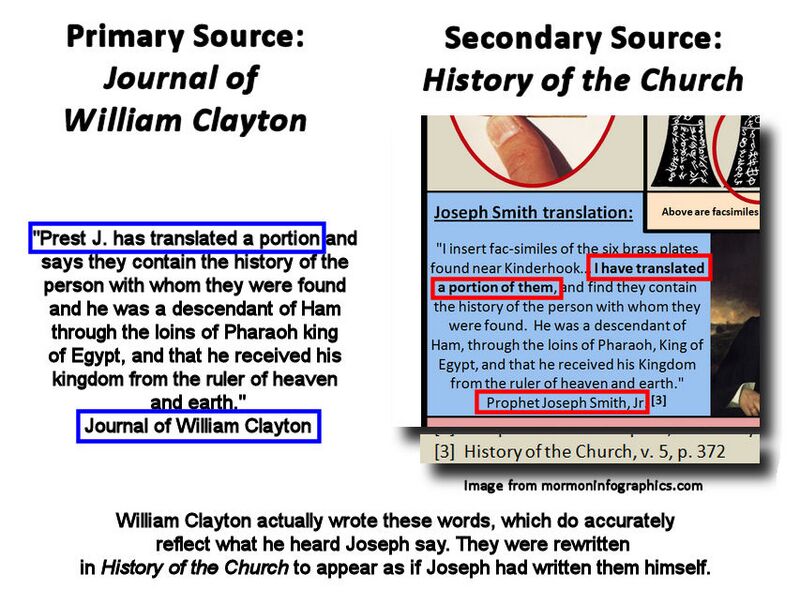
The graphic is correct, but it is useful to know the actual source of the quote used by History of the Church.:
I insert fac-similes of the six brass plates found near Kinderhook, in Pike county, Illinois, on April 23, by Mr. Robert Wiley and others, while excavating a large mound. They found a skeleton about six feet from the surface of the earth, which must have stood nine feet high. The plates were found on the breast of the skeleton and were covered on both sides with ancient characters. I have translated a portion of them, and find they contain the history of the person with whom they were found. He was a descendant of Ham, through the loins of Pharaoh, king of Egypt, and that he received his kingdom from the Ruler of heaven and earth.
The quote in question was written in William Clayton's journal. It was rewritten in the first person (as if Joseph Smith had said it himself) when it was included in History of the Church. Clayton's journal is the primary source, which was used in History of the Church (a secondary source).
The quote by William Clayton is indeed accurate: Joseph Smith did attempt to translate a portion of the Kinderhook Plates. This is explained in the following section.
The following is from Stanley B. Kimball, "Kinderhook Plates Brought to Joseph Smith Appear to Be a Nineteenth-Century Hoax," Ensign, August 1981 off-site
These two oblique references to a “translation” were followed thirteen years later by a more direct published statement that until recently was wrongly thought to have been written by Joseph Smith himself. On September 3 and 10, 1856, the following paragraphs appeared in the Deseret News as part of the serialized “History of Joseph Smith”:
“[May 1, 1843:] I insert fac similes of the six brass plates found near Kinderhook, in Pike county, Illinois, on April 23, by Mr. R. Wiley and others, while excavating a large mound. They found a skeleton about six feet from the surface of the earth, which must have stood nine feet high. The plates were found on the breast of the skeleton, and were covered on both sides with ancient characters.
“I have translated a portion of them, and find they contain the history of the person with whom they were found. He was a descendant of Ham, through the loins of Pharaoh, king of Egypt, and that he received his kingdom from the ruler of heaven and earth.” (Then followed a reprint of material from the Times and Seasons article.)
Although this account appears to be the writing of Joseph Smith, it is actually an excerpt from a journal of William Clayton. It has been well known that the serialized “History of Joseph Smith” consists largely of items from other persons’ personal journals and other sources, collected during Joseph Smith’s lifetime and continued after the Saints were in Utah, then edited and pieced together to form a history of the Prophet’s life “in his own words.” It was not uncommon in the nineteenth century for biographers to put the narrative in the first person when compiling a biographical work, even though the subject of the biography did not actually say or write all the words attributed to him; thus the narrative would represent a faithful report of what others felt would be helpful to print. The Clayton journal excerpt was one item used in this way. For example, the words “I have translated a portion” originally read “President J. has translated a portion. …”

FAIR is a non-profit organization dedicated to providing well-documented answers to criticisms of the doctrine, practice, and history of The Church of Jesus Christ of Latter-day Saints.
We are a volunteer organization. We invite you to give back.
Donate Now